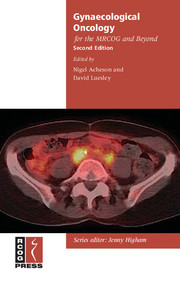Book contents
- Frontmatter
- Contents
- About the authors
- Preface
- Introduction to the second edition
- Abbreviations
- 1 Basic epidemiology
- 2 Basic pathology of gynaecological cancer
- 3 Preinvasive disease of the lower genital tract
- 4 Radiological assessment
- 5 Surgical principles
- 6 Role of laparoscopic surgery
- 7 Radiotherapy: principles and applications
- 8 Chemotherapy: principles and applications
- 9 Ovarian cancer standards of care
- 10 Endometrial cancer standards of care
- 11 Cervical cancer standards of care
- 12 Vulval cancer standards of care
- 13 Uncommon gynaecological cancers
- 14 Palliative care
- 15 Emergencies and treatment-related complications in gynaecological oncology
- Appendix 1 FIGO staging of gynaecological cancers
- Index
4 - Radiological assessment
Published online by Cambridge University Press: 05 August 2014
- Frontmatter
- Contents
- About the authors
- Preface
- Introduction to the second edition
- Abbreviations
- 1 Basic epidemiology
- 2 Basic pathology of gynaecological cancer
- 3 Preinvasive disease of the lower genital tract
- 4 Radiological assessment
- 5 Surgical principles
- 6 Role of laparoscopic surgery
- 7 Radiotherapy: principles and applications
- 8 Chemotherapy: principles and applications
- 9 Ovarian cancer standards of care
- 10 Endometrial cancer standards of care
- 11 Cervical cancer standards of care
- 12 Vulval cancer standards of care
- 13 Uncommon gynaecological cancers
- 14 Palliative care
- 15 Emergencies and treatment-related complications in gynaecological oncology
- Appendix 1 FIGO staging of gynaecological cancers
- Index
Summary
Introduction
Radiological assessment forms an integral part of the multidisciplinary management of gynaecological cancers. This chapter describes the role of imaging modalities in gynaecological cancer.
Ovarian cancer
There are two main goals of imaging in this area:
• to differentiate benign from malignant ovarian masses
• to aid management in patients with ovarian malignancy.
DIFFERENTIATING BENIGN FROM MALIGNANT OVARIAN MASSES
Pelvic ultrasound is the primary imaging modality in the assessment of ovarian masses. The transvaginal route is preferred to the transabdominal, as the higher-frequency probes used have better resolution, giving a more detailed assessment of the mass. High-frequency probes have a limited range: a maximum depth of view 6–10 cm, so the two techniques are used in conjunction. This is particularly important if the mass is large.
There are ultrasonic features which correlate with malignancy and these have been incorporated into the risk of malignancy index (RMI). The RMI is used to predict whether an ovarian mass is malignant. As discussed in Chapter 9, the RMI is based on the findings at ultrasound, the pre- or postmenopausal state and the serum CA125 level.
The most significant pointer of malignancy at ultrasound is an indication of solid elements, particularly if blood flow can be demonstrated within the ovary by using colour or power Doppler. Blood clot and collections can also simulate solid masses but will have no blood flow.
Keywords
- Type
- Chapter
- Information
- Gynaecological Oncology for the MRCOG and Beyond , pp. 53 - 66Publisher: Cambridge University PressPrint publication year: 2011

